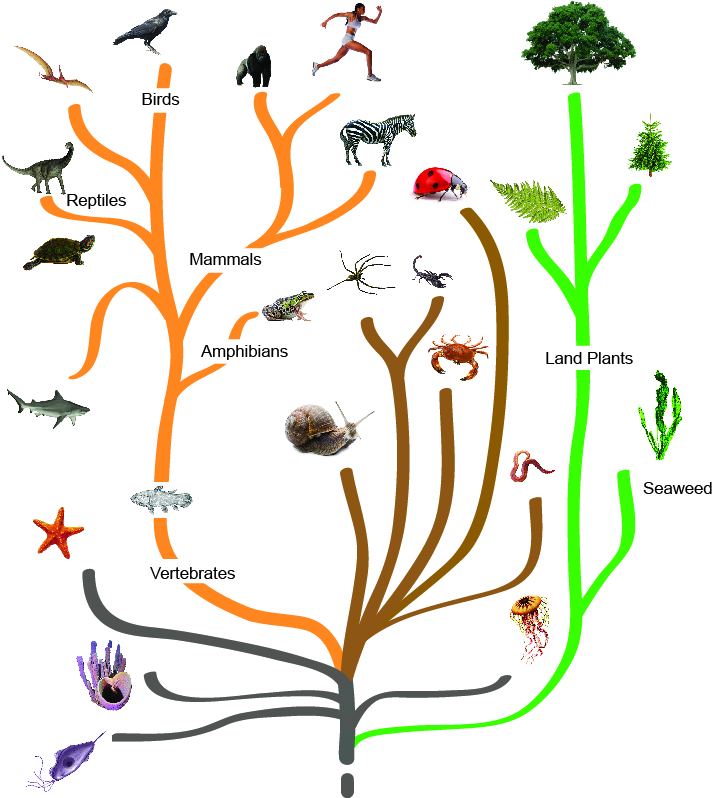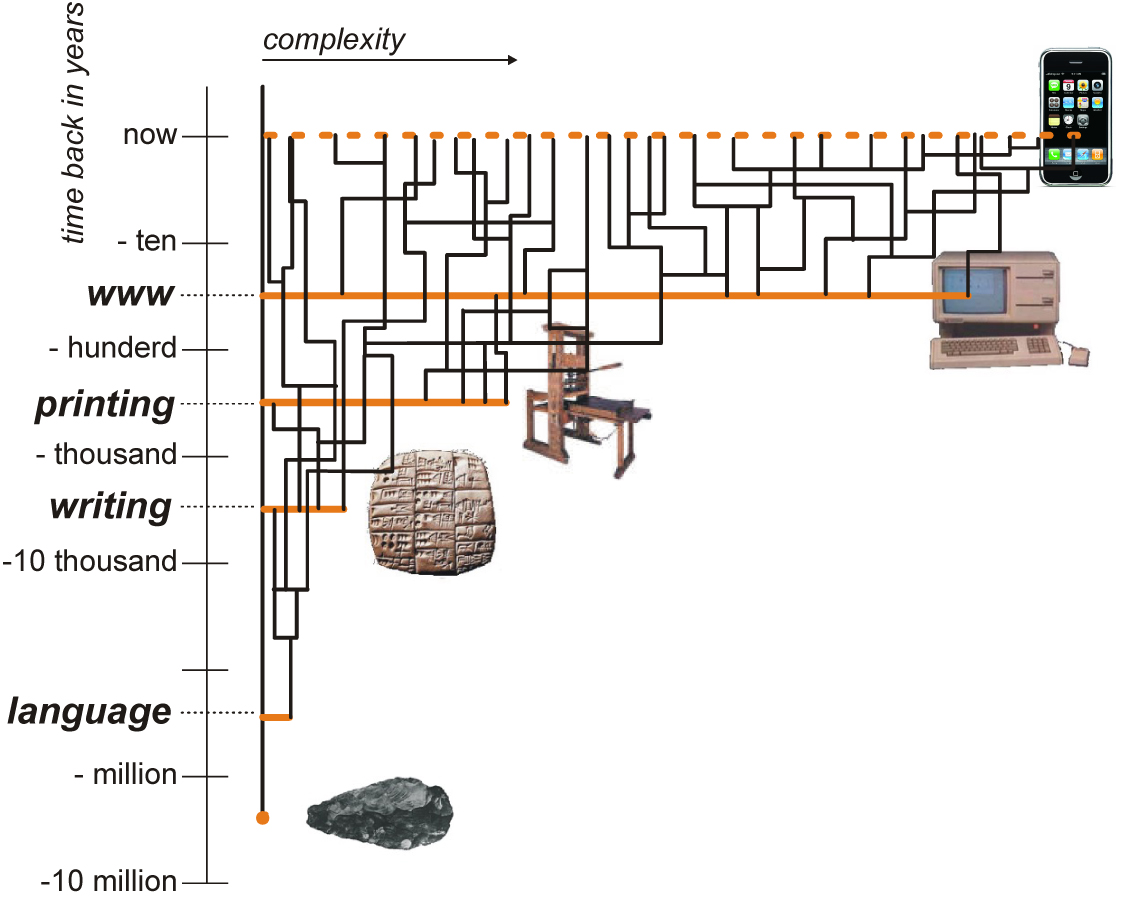This post discusses the tree of life metaphor in relation to man-made goods and includes a proposed figure depicting the evolution of man-made goods.
For a long time I have been fascinated by both evolution in biology and innovation in technology. In 2010 this led to the start of a PhD research project with the title ’Technological Innovation as an Evolutionary Process’. It soon transpired that I was not the only one following this trail of thought. In 1988 Basalla published a book titled The Evolution of Technology and in 2000 a book edited by Ziman with exactly the same title as I used for my project was published (with a paperback edition following in 2003). In addition to this I soon came across a paper titled ‘The evolution of science policy and innovation studies’ by Ben Martin that reviews the growth of a body of knowledge that closely relates to my field of interest. I was therefore able to draw on a significant and growing body of literature.
The thoughts posted below predate my above-mentioned research project. I am sharing them here because I consider them to be relevant to the debate on evolution in products and because they have helped create an interesting figure. The start of a my train of thoughts that led to this figure (2) were a number of observations that anyone could have made on the topic of evolution and innovation.
- The origin of both species and products goes back a long time (although for species it is measured in billions of years and for products in millions of years).
- Neither species nor products could have emerged with the high levels of complexity and diversity we know today (that is, without divine intervention). A plausible explanation for the emergence of both species and products is offered by evolution based on the assertion that they must have started out with a low level of complexity and diversity, which then increased over time.
- In the case of biological evolution genes were discovered as being the ultimate smallest unit in which information is stored. Memes have been proposed as the unit of information for human culture including technology. However, memes have not (yet) provided an explanation for the mechanism of technological evolution in the same way as genes have done so for biological evolution (see also my post on rates of speciation). As a result we cannot reconstruct an unambiguous origin of products like the phylogenetic tree provides for species.
- The historical development in complexity and diversity appears to be non-linear and episodic for both species and products. In the case of species it is known that there was a sudden and huge increase in the number of species (organisms) during the so-called Cambrian explosion that occurred between 541 and 520M years ago. Many species also disappeared again in extinction waves. In the world of man-made things we can also detect changes in complexity and diversity that are commonly associated with so-called technological transitions. Examples of technological transitions are (current) digitalisation, electrification and also the start of the Bronze Age. For the evolution of products, changes in the way we share information (the origin of language > writing > printing > digital communication) appear to coincide with important changes in human societies and to be inseparably connected to the products we make and use.
Changes in the way we share information appear to coincide with important changes in human societies and to be inseparably connected to the products we make and use
For biology the tree of life, based on Linnaean classification, was initially the generally accepted way of portraying the evolutionary journey from the first forms of life to the most recent ones. More recently this Linnaean tree has been replaced by the phylogenetic tree, which is based on measuring genetic distance between species.

In the last few decades, a lot has been discovered and written about the first tools used by our ancestors. These publications tell us that the first of these stone tools were used at least 2.5 million years ago. Before I started my PhD project, I asked myself the question of whether there could be a ‘tree of life’-like way to map how products evolve (note: I deliberately use tools and products interchangeably but they mean the same). I wondered if one could draw a tree-like diagram that starts with stone tools and then connects up to modern tools like the smartphone.
The first of these stone tools were used at least 2.5 million years ago
Products are not living entities and do not have genes that can be read or measured. Knowing that the study of memetics did not provide any insights that would make it possible to draw family tree diagrams first suggested that it made no sense to search for such a framework for products. However I did not want to be discouraged so soon and set out to find out if it would make sense in the context of mapping different types of products through time.
I drew below figure based on the observations listed as bullets above. The horizontal axis provides a measure of complexity of products (e.g., printing press being more complex than the clay tablet). I must mention here that I do not have a measure of complexity. Therefore, the horizontal axis is not quantified. Its only purpose is to provide a relative distinction between lower and higher complexity.
For the vertical time axis I used a logarithmic scale because there has been a tremendous amount of development and increase in complexity in recent times, while the further back we go in time, the slower the pace of development and the lower the complexity. On the vertical time axis I added coloured horizontal lines marking transitions/changes in the way we share information.

The first or lowest coloured line is intentionally positioned quite inaccurately. The reason for this is that there is no scientific consensus as to when to date the origin of human language. Human language does not leave fossils, hence it is very hard, if not impossible, to find conclusive evidence of its first appearance. However, it is clear that our species has had language capabilities for well over 10 thousand years, possibly over a 100 thousand years. Some scholars argue that proto-languages evolved more than a million years ago (thus before Homo sapiens existed).
Because it is impossible at present to date the exact start of language as we know it, I have positioned it below the 100 thousand and above the one million years markers. It could just as easily be positioned a bit higher or lower.
A form of gesture language may have been sufficient to convey the knowledge and skills required to make stone tools
Given that the oldest stone tools are at least 2.5 million years old, the following question arises. What type of language was required for stone tools like the meticulously shaped hand axe to emerge? Since linguists now assume that spoken word as we know it did not yet exist 2.5 million years ago, a form of gesture language may have been sufficient to convey the knowledge and skills required to make stone tools.
The other markers (origin of writing on first clay tablets), first printing press (by Gutenberg) and the start of large-scale digital electronic communication (use of internet) are well documented and dated. The lines linking the first and most recent product are not a representation of actual lines of descent. Instead they are based on the idea that knowledge (/artefacts/products) is a result of accumulation and that, somehow, earlier versions therefore relate to later ones.
Figure 2 suggests that each next step change in complexity of products takes place roughly 10 to 100 times faster (with the 1st step change being inaccurately positioned). The process from first language to writing took place in the range of 10E5~10E6 years. Writing to printing took place in the range of 10E3~10E4 years and printing to full digital communication took place in the range of 10E2~10E3 years. This suggests that the next step change can be expected in a time span measured in decades to centuries, measured from the last transition (Morse code up to and including www). Possibly this is the singularity suggested by Ray Kurzweil that marks a moment in the mid of the 21st century when artificial intelligence (AI) is expected to become infinitely more powerful than all human intelligence combined. Although I admit it is highly speculative, the singularity prophesied by Kurzweil as mapped in Figure 2 might imply that we will then face another transition in terms of the complexity and sophistication of the products we produce.
If it is possible to picture a tree of products from a first type to a latest type, then it should also be possible, on a smaller time scale, to picture the lineage for a particular type of product
Besides the above suggestion relating to AI, for which I had no intention of investigating in any greater detail, I now had a sort of first ‘tree-of-products’, but no clue as to whether it actually makes sense to picture the evolution of products in a tree-like diagram. To investigate this, I set my self a more manageable challenge. If it is possible to picture a tree of products from a first type to a latest type, then it should also be possible, on a smaller time scale, to picture the lineage for a particular type of product. Thus, instead of starting at the earliest beginnings (for which there is very little easy to access information, if at all), this would mean starting with some existing products (for which lots of information is available) and then working backwards. I invite anyone who is interested in seeing what this resulted in to read ‘On the Origin of Products’. This book explores the topic of ancestry in products and proposes a framework (the Product Evolution Diagram) to picture how particular products emerged and evolved through time.
Copyright © 2017 Huub Ehlhardt. All Rights Reserved. Please contact us for re-use of this article.


Dear Huub
Reading your website is a pleasure. I liked the tree of languages, especially.
The history of products is an intriguing subject, I myself have written articles on the evolution of the piano mechanism, on carburetors becoming electronic injection, and lately, on the developments in design of electric motors in roll down shutters.
There are obvious similarities between product history and natural evolution. New types emerge from earlier ones. In hindsight, products have a lifecycle in their maturity.
However, I have never felt the urge to use evolutionary vocabulary to describe the history of product. Why?
Natural evolution, I gather, is the process in which slightly new lifeforms replace earlier lifeform if they fit their environment better. It is a process of natural selection of the best fit. The process requires no effort except procreation over generations. It just happens, there is no purpose and no intelligent design in the evolution of nature. It leads to a variety of species, each best adapted best to their own specific environment. What characterizes the origin of species is the absence of men in it, until recently.
Artifacts however, are created by men, and thus they are not part of natural evolution. Artifacts do not procreate, they are created by the humans in a societies, in search for power and prosperity. The products become better and more diverse due to the accumulation of knowledge in science, technology, commerce and trade. Well-educated, liberal and enlightened societies do best.
To state that products have an evolution suggests a purposeless and effortless process. It denies the role of designers. Men are at the cause of product evolution. In product evolution we must pay homage to all the creators that have been at work, who, paraphrasing the poet Kloos ” are all Gods in the deepness of their thoughts”.
So, the evolution of products is essentially different from the evolution as it dawned on Darwin.
For me, there is second reason to avoid the term evolution in product design, and that is responsibility.
Natural evolution did create a breathtaking paradise and we lived in it only since recently. Men did not have a part in its coming about, although some of us designers may be arrogant enough to claim that they could have provided God with some valuable advice, had they been present from day 1 (smiley).
The man-made product evolution has left to us living on the breathtaking junk yard that we live on today. To claim an evolutionary character in product design suggests that this pollution has happened in a similar natural flow, in which humans have no role. Designers should not be exonerated or provided an opportunity to hide behind an analogy to natural evolution.
On the other hand, is there anything that we can learn from “the origin of species” that helps us, lesser gods, to avoid the catastrophe that we are heading for: the end of species?
Cheers
Hein
Dear Hein,
Thank you for your reaction.
You state that artefacts are not a part of natural evolution, which is a logical and fair comment. However, my argument is that this exclusion does not mean that evolutionary statements are thus worthless in explaining the development of ‘things’ without metabolism. Take for example languages, which are a key example of human culture. Nobody will claim that languages are alive in the sense that they have metabolism, procreate, let alone that there is a type of hereditary code embedded in a molecular structure associated with it. Nevertheless, linguists now use language trees (like the one in my blog about speciation) to show how different languages relate to each other. And they use an evolutionary process of descent with modification to explain how earlier languages over time change into later languages. This is a clear case of evolution in human culture and thus well beyond the realm of ‘biological life’.
Let’s now consider ‘products’ which I define in ‘On the Origin of Products’ as something designed to realize a specific function, and based on accumulated know-how (to make) and know-what (function to realize).
I have no intention here to ignore the role of designers, engineers, inventors or others involved in the development of products. In general they are, and I know this from own experience, passionately involved in the development of products they work on. Nonetheless, what these developers essentially do, is creating (new) variants and configurations of existing know-what and know-how. And in doing so, pushing the limits into new territory, hence creating add-ons to existing knowledge. And it is this accumulating knowledge on which that evolutionary process works. The resulting products we might consider as ‘vehicles for selfish memes’ to paraphrase Dawkins.
And last but not least, the argument of responsibility of designers. I do not see why an evolutionary explanation for the origin of products relieves designers from whatever responsibility. Similar like whatever reasoning one uses for the origin of life on earth (either a divine cause, or natural evolution) is no excuse for avoiding our responsibility for keeping our planet habitable. Responsibility and fascination go hand in hand. And for sure, designing products is a truly fascinating job!
best regards,
Huub
Do you mind if I quote a few of your articles as long as I provide credit and sources back to your
website? My blog is in the exact same area of interest as yours and my users would certainly benefit from a lot of the information you present here.
Please let me know if this okay with you. Regards!
Hi,
Please go ahead as you propose.
I am curious to see your site. However the link provided below (https://pastelink.net/h8qic6xz) does not work for me.
kind regards,
Huub
Dear Huub
Thank you very much for your important contribution to product evolution research. My research is about product form evolution. Your research on product evolution has been of great help to me. I read your book ON THE ORIGIN OF PRODUCTS many times. My master’s thesis and journal articles also cited your article.Thank you so much !DOI:10.16771/j.cn43-1247/ts.2023.12.012. Attached here is my article, I would be grateful if you would give some guidance.
Best regards
DDD
Dear DDD, I am curious to read your article but can not find anything with the DOI you provided.